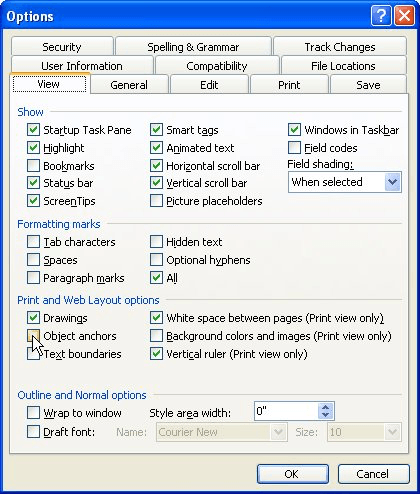Please Note: This article is written for users of the following Microsoft Word versions: 97, 2000, 2002, and 2003. If you are using a later version (Word 2007 or later), this tip may not work for you. For a version of this tip written specifically for later versions of Word, click here: Understanding Object Anchors.
Written by Allen Wyatt (last updated September 22, 2020)
This tip applies to Word 97, 2000, 2002, and 2003
Objects can be placed in your document in two ways: either inline or floating. Inline objects are those that reside on the same layer as your text and are positioned within the stream of text that surrounds the object. Floating objects are those that are placed on a layer over the text. The thing that indicates essentially where a floating object is located in relation to the text in your document is referred to as an object anchor.
Object anchors can only be seen in Print Layout view, but even then they are not always visible. In other words, you can control the display of the anchors. If you select a graphic object in your document and you see a boat-anchor icon appear in the left margin of the document, then you know you have the display of object anchors enabled. You can change this setting by following these steps:

Figure 1. The View tab of the Options dialog box.
Object anchors are used to specify the paragraph with which an object is associated. Why is that important? Because it can affect the positioning of the object within the document. For instance, if you select a picture and then choose Picture from the Format menu, you will see the Format Picture dialog box. The Position tab of that dialog box allows you to set the vertical position of the picture in relation to the paragraph to which it is anchored. Thus, seeing the object anchor helps you to understand the positioning of the picture.
In addition, the Position tab allows you to select a check box named Lock Anchor. This option causes Word to always paginate your document so that the object (the picture) is always on the same page as the object anchor. This is the best way to ensure that a picture is on the same page as the paragraph that describes what is in the picture.
WordTips is your source for cost-effective Microsoft Word training. (Microsoft Word is the most popular word processing software in the world.) This tip (1439) applies to Microsoft Word 97, 2000, 2002, and 2003. You can find a version of this tip for the ribbon interface of Word (Word 2007 and later) here: Understanding Object Anchors.

Comprehensive VBA Guide Visual Basic for Applications (VBA) is the language used for writing macros in all Office programs. This complete guide shows both professionals and novices how to master VBA in order to customize the entire Office suite for their needs. Check out Mastering VBA for Office 2010 today!
An Access database can store all types of data, including graphic images. Merging most data from Access into Word is ...
Discover MoreWord allows you to easily add images to your documents. For documents intended for monochrome printers, grayscale images ...
Discover MoreWhen you insert pictures into a document, the first folder that Word opens up is normally the My Pictures folder. You can ...
Discover MoreFREE SERVICE: Get tips like this every week in WordTips, a free productivity newsletter. Enter your address and click "Subscribe."
2016-06-06 12:17:07
Hi, I am Bob McDonalds. Thank you for teaching me how to use this. It was very useful and I enjoyed it. Once again, thank you!
-Bob McDonalds
2015-03-24 09:33:26
Cindy Doty
Where is the Position tab to in order to select the check box named Lock Anchor?
2015-03-08 14:48:46
David
I use lock anchor to force Word to keep an object locked to a particular line of text so that editing does not move the anchor. It seems to work for me but am I mistaken?
Got a version of Word that uses the menu interface (Word 97, Word 2000, Word 2002, or Word 2003)? This site is for you! If you use a later version of Word, visit our WordTips site focusing on the ribbon interface.
Visit the WordTips channel on YouTube
FREE SERVICE: Get tips like this every week in WordTips, a free productivity newsletter. Enter your address and click "Subscribe."
Copyright © 2024 Sharon Parq Associates, Inc.
Comments